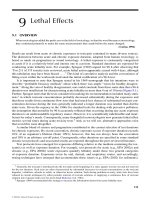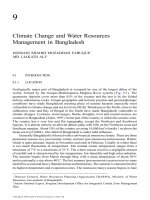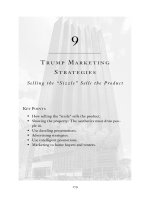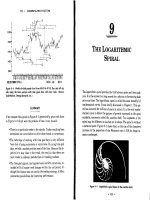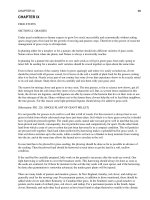Hedges on Hedge Funds Chapter 9 docx
Bạn đang xem bản rút gọn của tài liệu. Xem và tải ngay bản đầy đủ của tài liệu tại đây (158.46 KB, 10 trang )
CHAPTER
9
CHAPTER 9
The Time Is Now for Equity
Market Neutral
A
s is the case with convertible arbitrage and fixed-income hedge fund
investing, equity market neutral is characterized as a relative value
strategy. However, it is not pure arbitrage; this strategy generally trades
on the differences in value across a wider range of less closely related
securities, which is not the case in convertible arbitrage and fixed-income
arbitrage.
Equity market-neutral managers construct portfolios that have close
to equal amounts of offsetting long and short equity positions. By bal-
ancing long and short positions, market-neutral managers attempt to
mitigate events that affect the valuation of the stock market as a whole,
which implies very low or no correlation to the market. Investors in
equity market neutral strive to generate consistent returns in both up and
down markets.
To determine the right time to start ramping up the market-neutral
allocation to one’s investment portfolio, it is first necessary to understand
what has been holding this strategy back as compared to other strate-
gies. Examination of recent past performance might help determine
when these adverse conditions have been alleviated. Investor sentiment
points to the lack of market volatility as the culprit, yet this is not en-
tirely accurate. Although volatility is indeed vital to the success of many
market-neutral strategies, statistics support the fact that volatility is
not the sole issue with which to be concerned. The popular VIX, Chicago
133
c09_hedges.qxd 8/30/04 12:10 PM Page 133
Board Options Exchange volatility index, which measures implied vola-
tility, has been registering a comfortable mid-20s reading since 1997,
which is impressive considering that a register of 20 is considered
healthy volatility. This average had not been seen since the Gulf War
days and suggests no lack of overall market volatility.
That index is, however, not perfect, because it measures end-of-day
implied volatility; intraday volatility would provide a better sense of the
opportunities available during the day. However, since it is the best
measure available, it is worth analyzing in more detail. Consider a re-
gression analysis, where the VIX Index is the independent variable and
the HFR Equity Market Neutral Index over the last decade or so is the
dependent variable. The correlation is around −6 percent, strongly sug-
gesting that overall volatility should not be viewed as the primary driver
of market-neutral returns. Clearly, however, low market volatility tends
to decrease the number of alpha-generating opportunities available to
equity market-neutral managers. When market volatility subsides, mar-
ket efficiency tends to rise. As mentioned, equity market-neutral managers
prefer those periods of volatility so that they can go after additional prof-
its. (See Table 9.1.)
134 HEDGES ON HEDGE FUNDS
TABLE 9.1 CBOE Volatility Index Gauges Market Volatility
Year VIX
1997 24.01
1998 24.42
1999 23.40
2000 26.85
2001 23.80
2002 28.62
2003 18.31
Source: Provided courtesy of Chicago Board Options
Exchange, Incorporated.
The VIX Index, a key measure of market expectations of near-term
volatility conveyed by S&P 500 stock index option prices, is
considered by many to be the word’s premier barometer of investor
sentiment and market volatility.
c09_hedges.qxd 8/30/04 12:10 PM Page 134
The Time Is Now for Equity Market Neutral 135
Managers use a variety of methods to mitigate market influence on
their funds. Some use pair trading, which involves purchasing one secu-
rity and selling short a fundamental sibling using a preset ratio to elim-
inate the effects of market and sector risks. For example, if an investor
bought Diamond Offshore Drilling and sold short Noble Drilling Corp.,
he or she would be exposed to similar risks on a market and sector basis
because both companies are energy drilling ones with similar assets
located in similar geographic regions. The key to success relies on deter-
mining which security to buy and which to sell. In essence, the process
aims to isolate the security selection skill of portfolio managers or, in the
case of technical managers, their ability to construct the appropriate
models to capture the relative inefficiencies between securities. Talented
managers can do this effectively and capture alpha from dynamics that
may alter the spread between securities. Others add, or use exclusively:
a beta-neutral strategy, where positions are taken based on a stock’s
level of market risk; a dollar-neutral strategy, where equal dollars are
invested on both the long and short sides; mean regression, where posi-
tions are taken with the idea that the securities will revert to their his-
torical relationships their trading relationship will hold; or numerous
other combinations.
No universally accepted definition of equity market neutral exists,
yet an increasing commonality among funds executing this strategy is
the use of complex statistical models to capture numerous market-
neutralizing dynamics.
These hedge funds can appear attractive because they are designed
to make money regardless of market movement and thus tend to be safe
havens for excess capital. Because the strategy is generally long and
short similar equities, the absolute direction of the securities matters less
than the relative movement of the securities. Provided the long outper-
forms the short, the strategy will make money. The strategy’s return is a
function of the movement of the long and short security in addition to
dividends received and paid, which are added to the short sale interest.
The obvious question is how the equity market-neutral strategy has
performed relative to the market. The HFR Market Neutral Index,
which monitors a broad representation of equity market neutral hedge
c09_hedges.qxd 8/30/04 12:10 PM Page 135
136 HEDGES ON HEDGE FUNDS
funds, has maintained a less than 15 percent correlation to the S&P 500,
Dow Jones, Nasdaq, and the Morgan Stanley Capital International
Europe, Australasia, Far East, which measures international equities. In
addition, the Market Neutral Index has maintained a far superior risk-
adjusted return to the broad market, as evidenced in a much greater
Sharpe ratio.
At the most general level, return from equity market neutral is
derived from three sources: profits of both long and short positions and
interest from margin deposits on the short positions. More specifically,
the key factors that drive returns for this strategy include market volatil-
ity, market rationality, and not-so-strong bull markets.
Market volatility is important because it allows managers to benefit
from information inefficiency by capitalizing on times when certain stocks
may be trading away from their fundamentals, based on something not
being factored in correctly or because of numerous other events.
Market rationality is probably the most critical driver of profitabil-
ity of equity market-neutral managers. The strategy profits when mar-
ket perception and reality are aligned, specifically, in an environment
where good earnings announcements and earnings growth lead to higher
stock performance and, conversely, when no earnings or growth poten-
tial lead to lower stock performance of companies. Therefore, to market-
neutral managers, security selection is a vital component of success.
Equity market neutral involves trading absolute positions for relative
outperformance and, as a result, which side of the trade tends to matter
more than the trade itself. As a result, if the perception/reality argument
is out of line, the strategy will suffer. (See Table 9.2.)
Strongly bullish markets matter in that during these times, equity
market neutral will tend to underperform the market simply because
TABLE 9.2 Market-Neutral Equity at a Glance
Historical return 10%–12%
Historical volatility Low (3%–5%)
Risk characteristics Conservative
Expected correlation
with equity markets Low (0.1)
c09_hedges.qxd 8/30/04 12:10 PM Page 136
returns are truncated by the short security component of returns. In
strongly bear markets, the strategy tends to outperform the market.
What is needed to swing the market-neutral pendulum into vogue is
a realignment of reality and perception. This situation will occur when
earnings and cash flow performance are reflected in the movements of
security prices. During the past couple of years, attention has focused on
the fact that implied valuation of the market was too high, and the de-
bate thus was about “irrational exuberance,” the need to change valua-
tion parameters in a new economy, and, more recently, the quality of
earnings. These discussions focused on broad valuation issues rather than
on individual security circumstances. Even now, with the market having
adjusted somewhat since the Internet years, the forward price/earnings of
the S&P 500 is still over 20 times next year’s earnings. This is not cheap
by any stretch of the imagination, given historical standards, but is much
lower than the high-flying period from late 1998 to early 2000.
More critical than forward multiples, though, is the perception ver-
sus reality argument. Specifically, the environment should show good
earnings announcements and earnings growth to achieve higher stock per-
formance. Back in the dot-com heyday, market-neutral managers found
themselves laggards to their competitors because they were managing
against the seemingly unreachable expectations of dot-com companies.
Good news translated not only into better stock performance, but also
into unjustifiable security performance. Scores of companies announced
better-than-expected numbers only to see their stock plummet, while oth-
ers missed their expectations and witnessed an appreciation of their
security. In short, the environment was dominated by macro factors,
which thus relegated individual security valuation issues to a subordi-
nate role. Indeed, even though fund managers may have made the cor-
rect analysis on a security relative to other comparables, losses may have
resulted because the market was looking past valuations. Although this
example is a simple one, it highlights how good fundamental work still
can lead to bad results.
Security selection risk is critical to the success of the strategy. Because
of the relative return nature of the strategy, being able to choose the
outperformers and underperformers is the bottom line in equity market
neutral. Rational markets are vital to the strategy’s success. The strong
The Time Is Now for Equity Market Neutral 137
c09_hedges.qxd 8/30/04 12:10 PM Page 137
bull market of late is characterized by investors rewarding speculative
lower quality stocks making it very difficult to identify short candidates.
The unusual component of this market behavior was persistence, some-
thing that many market-neutral managers have not experienced in the
past. (See Figure 9.1.)
The year 2003 brought another problematic year for equity market-
neutral managers. The HFRI Market Neutral Index posted returns of
−2.38 percent, while the S&P 500 and the Nasdaq posted returns
of 28.3 percent and 50.6 percent, respectively. The strong bull market
adversely affected the strategy, held back by the mandated offsetting
short equity positions. The end of the war in Iraq, low interest rates,
favorable tax law changes, and fiscal stimulus helped create a strong
rally in the equity markets that persisted throughout the year. Investors’
willingness to increase their risk tolerance helped push higher not only
undervalued quality stocks, but also low-quality speculative stocks that
are usually held short by market-neutral managers. Consequently, for
most of the year, market-neutral managers saw the gains in their long
portfolio more than offset by losses in their short portfolio. This per-
sistence has happened only two other times since 1986. The rally in low-
quality stocks was further aggravated by the “short squeeze” when
managers trying to cover their short positions pushed prices even higher.
Market-neutral managers who focused on mean regression also suf-
fered from a market where opportunities for this style of trading were
minimal. Reduced market volatilities persisted for most of the year, pro-
viding very little mean reversion opportunities for statistical arbitrage
market-neutral funds. The decline in volatilities was attributed to the
very low level of dispersion among investors throughout the year as
the equity market rallied.
The U.S. economy grew approximately 4.4 percent in the first quar-
ter of 2004. There is strong evidence that employment is improving, and
despite an expected slowdown in consumer spending, capital spending
is expected to take up the slack given the improvement in corporate bal-
ance sheets. Some potential factors could slow growth, in particular
geopolitical risks or an extended pause in consumer spending. However,
despite these risks, it appears that the economic recovery will be sus-
138 HEDGES ON HEDGE FUNDS
c09_hedges.qxd 8/30/04 12:10 PM Page 138
Strategy Intention
Source of Profits
Risk Return Profile
Role in Portfolio
Risk Exposure
• Generate profits by taking offsetting long and short positions in related
equity securities
• Difference between the long and short positions
• Conversion on violations of the “law of one price”
• Purest form of alpha (verses equity indices)
• Low beta (generates returns with negligible exposure to market as a whole)
• Sustainable, smooth, positive returns
• Volatility reduction
• Portable alpha in fund of funds
• Average year: 10.23% Worst year: 2002 0.98%
• Interest rate risk: low
• Equity market risk: moderate
• Credit risk:
low
• Counterparty risk:
low
• Funding liquidity risk: moderate
• Leverage risk: low
• Operational risk:
moderate
Worst Case Factors:
• Strongly bull markets
• Low volatility markets
• High intraday volatility
Favorable:
• Volatile markets
• Information inefficiency
• Rationally driven market
Scenario Factors
Equity market neutral is a volatility reduction strategy,
with very low equity market beta.
FIGURE 9.1
Equity Market-Neutral Strategy Profile.
139
c09_hedges.qxd 8/30/04 12:10 PM Page 139
Interest Rate Risk
Funding Liquidity
Risk
Leverage Risk
Grey = Plane of Risk
Legend
5 = high exposure
1 = low exposure
0 = no exposure
• Low interest rate risk
• Low correlation to bonds
• Performed well in 1994
• Low credit risk
• Performs well in volatile
environment
• Increased with dwindling
volatility
• Increased in strong bull
markets
• Increased with high intraday
volatility
Operational Risk
Counterparty Risk
Credit Risk
Equity Market Risk
0
1
2
3
4
5
The dominant risk in equity market neutral is stock-
and manager-specific, both diversifiable.
FIGURE 9.2
Equity Market-Neutral Risk Profile.
Source
: LJH Global Investments, LLC.
140
c09_hedges.qxd 8/30/04 12:10 PM Page 140
tained throughout the balance of 2004, and additional inflationary pres-
sures from a falling dollar and fiscal deficits will most likely not push
the Federal Reserve from its accommodating stance to tightening until
later in 2004.
Investors will likely see a continuation of gains in the equity mar-
kets as favorable conditions accommodating fiscal and monetary policy
and positive gross domestic product growth continue. Corporations look
better positioned through recapitalization and reorganization; how-
ever, their equities are less undervalued than in 2003. As a result, inves-
tors most likely will focus more on fundamentals, such as earnings growth,
than speculation. The undervaluation of the market has been mostly elim-
inated, making opportunities from risky assets less prevalent. This fact
should help market-neutral managers to minimize some of the losses in
their short portfolio, allowing them to refocus on their analysis and secu-
rity selection skills. (See Figure 9.2.)
Inflationary pressures from commodity prices, a growing deficit,
and falling currency will most likely push interest rates higher late into
the second half of 2004, putting the brakes on equities and increasing
volatility. Statistical arbitrage market-neutral managers who benefit
from increased volatility should find the environment more favorable
especially in the latter part of 2004.
The Time Is Now for Equity Market Neutral 141
TIPS
Equity market neutral is a relative value strategy that trades on the
differences in value across a wider range of less closely related secu-
rities. Market-neutral managers attempt to mitigate events that
affect the valuation of the stock market as a whole by balancing
long and short positions. Because an investment in equity market-
neutral hedge funds strives to generate consistent returns in both
up and down markets, it can be a wise strategy in either an up or a
down market.
c09_hedges.qxd 8/30/04 12:10 PM Page 141
142 HEDGES ON HEDGE FUNDS
■ Pay close attention to the popular VIX (CBOE Market Volatil-
ity) Index, which measures implied volatility, and track how
when market volatility subsides, market efficiency tends to rise.
■ Know that equity market-neutral managers prefer volatile mar-
ket periods when they can attempt to realize additional profits.
■ Understand that other key factors that drive returns for equity
market-neutral hedge funds are market rationality and not-so-
strong bull markets.
■ Evaluate how equity market-neutral hedge funds mitigate mar-
ket influence on their funds through pair trading, beta-neutral
strategies, and so on.
■ Be cognizant that strategy returns are a function of the move-
ment of the long and short securities as well as to dividends
that are added to the short sale interest.
■ Monitor security selection risk, which is critical to the success
of the strategy; because of the strategy’s relative return nature,
being able to choose the outperformers and underperformers
is the bottom line in equity market neutral.
■ Realize that strong bull markets adversely affect the equity-
market-neutral strategy, which is held back by mandated offset-
ting short equity positions.
■ Understand that market neutral managers who focus on mean
regression suffer in a market where opportunities for this style
of trading are minimal.
■ Corporations now appear well positioned through recapital-
ization and reorganization, and investors are likely to focus
more on fundamentals, such as earnings growth, rather than
speculation.
■ Inflationary pressures from commodity prices, a growing deficit,
and falling currency will most likely push interest rates higher
late into the second half of 2004, putting the brakes on equities
and increasing volatility.
c09_hedges.qxd 8/30/04 12:10 PM Page 142


